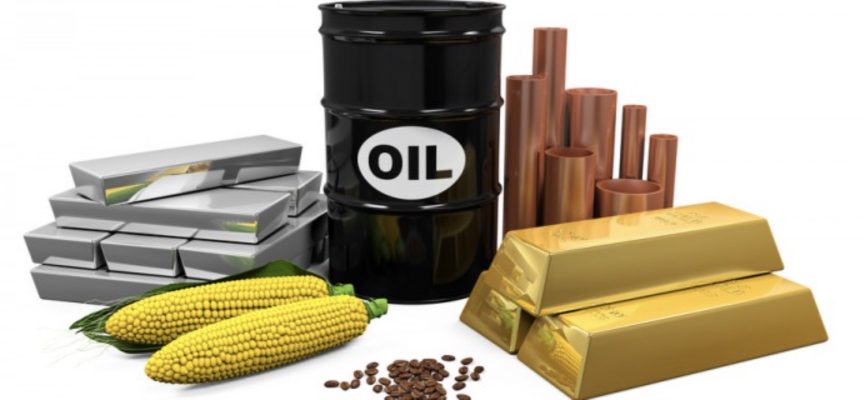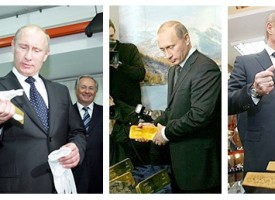A huge catalyst for the gold market is commodities. Is the commodities super cycle over or just paused?
Commodities SuperCycle Over Or Just Paused?
July 13 (King World News) – Gerald Celente: Seeing an economic slowdown in China and fearing a worldwide recession as central banks hike interest rates, commodities investors are bailing out into dollars and other safe harbors.
Copper was trading barely above $7,500 a ton last week, down 25 percent from its peak last fall above $10,700.
Copper continued to plunge on Monday, 11 July, and closed at $6,840 per ton.
The metal is known as “Dr. Copper” because its price fluctuations often diagnose the direction of metals and commodities markets more broadly.
Brent crude’s price fell below $100 a barrel last week for the first time since April. A global recession could decrease its price to $65 before next year, researchers at Citi told clients.
The S&P’s GSCI index of agricultural prices reached an all-time high in mid-May but has plunged 28 percent since then, the Financial Times reported. The London Metal Exchange’s measure of six industrial metals has lost a third of its value since March.
Investors think worse is ahead…
To find out which gold & copper explorer just hit significant mineralization click here or on the image below

In the week ending 28 June, investors liquidated 153,660 futures contracts worth about $6.2 billion, according to the federal Commodities Futures Trading Commission.
It was the second largest such reversal in history, Peak Trading Research reported.
The sell-off has been led by hedge funds, many of whom are “taking their chips off the table [and] leading big liquidation flows,” David Whitcomb, Peak Trading’s research chief, told the Financial Times.
Florin Court Capital has shorted—placed bearish bets on—copper, iron ore, nickel and zinc, “as markets begin to focus on the considerable risks of a hard landing,” Douglas Greenig, Florin’s founder, said to the FT.
Traders are skittish about the U.S. Federal Reserve’s stated plan to raise interest rates aggressively, which is likely to add to the global economic slowdown now under way and perhaps also lead to a recession.
Aspect Capital began shorting cocoa, copper, iron ore, silver, steel, sugar, and wheat in May.
Copper, which led metal prices skyward last year, has felt the brunt of investor fears, with 60,000 short contracts betting against 1.5 million tons in place on 30 June—the second highest number on record—compared to just 4,000 on 1 May, commodities brokerage Marex said.
“We don’t anticipate metals’ outlook—copper included—to improve until we see a change in Chinese demand,” Darwei Kung, commodities chief at DWS Group, told The Wall Street Journal.
China accounts for about half of the world’s copper consumption.
“The market is looking ahead six months and saying if orders don’t come through and China doesn’t rebound, we will have higher inventories and things will look a lot worse,” portfolio manager George Cheveley at asset manager Ninety One said in an FT interview.
“You have to have a very bearish outlook to come up with that scenario,” he added, “but the market is quite prepared to believe that at the moment.”
TREND FORECAST:
With China’s economy stalling, Europe about to topple into Dragflation, our Top 2022 Trend, the developing world poised on the edge of insolvency (see “Emerging Nations Stumble Toward Debt Default” in this issue), and inflation still rising, the commodities frenzy is over.
Prices of key materials, especially metals and timber, will no longer soar but will continue to remain above pre-COVID levels.
Mining operations were paused and new projects shelved during the COVID War, leaving minerals companies two years behind on production. Meanwhile, available supplies were used in meeting roaring consumer demand during the COVID shutdown and since.
Even in a recession or Dragflation, commodities prices will not return to pre-COVID levels…
One Of The Best Silver Plays In The World Just Became
One Of The Best Gold Play In The World!
TO LEARN MORE CLICK
HERE OR BELOW.
Big Trade Surplus
Russia amassed a 28-year record $70.1-billion trade surplus in this year’s second quarter as soaring prices for its exports of oil and other natural resources negated effects of Western sanctions imposed to punish Russia for attacking Ukraine, Bloomberg reported.
The surplus was the greatest since at least 1994, according to data the Bank of Russia released last week.
The sanctions halted Russia’s imports from the West, which also aided the surplus.
For this year through 30 June, the country’s trade surplus totaled $138.5 billion, the central bank reported.
Second-quarter exports amounted to $153.1 billion, slightly less than the $166.4 billion in the previous three months, according to the bank. Imports fell to $72.3 billion, compared to $88.7 billion in the year’s first quarter.
Export sales were aided by steep discounts on Russia’s goods.
It sells oil to India at prices 30 percent below those prevailing on the world market and is deeply discounting the price of coal it sells to China.
Russia no longer releases data about its foreign trade. However, Bloomberg was able to compile details by analyzing figures from Russia’s remaining trading partners.
“In May, there were signs imports had stabilized, with five countries accounting for about half of Russia’s trade as the economy adapted and business began to find new routes for shipments,” Bloomberg reported.
The trade surplus and stringent capital controls that have cut domestic demand for foreign currencies helped make the ruble the best-performing currency to date this year among emerging markets.
“A ballooning trade surplus says a lot about what’s going right for Russia, from high commodity prices to sustained demand from many export partners,” Bloomberg economist Scott Johnson said, “but it’s also a symptom of distress, with a plunge in imports sowing disruption throughout the economy.”
TREND FORECAST:
The trade surplus helps Russia in the short term but only delays an inevitable economic crisis if the Ukraine war drags on long enough.
The Western sanctions on Russia—warfare by a different means—are slowly pinching Russia’s economy, while Russia’s use of its natural gas exports to Europe as a weapon are pitted against each other.
Should Russia decide to keep its Nord Stream 1 natural gas pipeline closed to Europe, Russia will gain an upper hand in the standoff.
And as we had forecast, Russia, rich in human and natural resources will break away from globalization and embrace one of our Top Trends for 2022, “Self-Sufficiency.”
And as a result of thousands of U.S. and European businesses leaving Russia, rather than eating and buying foreign products, Made-in-Russia will be the national business anthem.
***To listen to Alasdair Macleod discuss why the coming crisis will be far worse than anything seen in 2008 global collapse CLICK HERE OR ON THE IMAGE BELOW.
© 2022 by King World News®. All Rights Reserved. This material may not be published, broadcast, rewritten, or redistributed. However, linking directly to the articles is permitted and encouraged.









